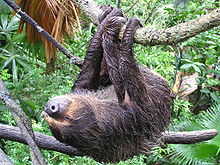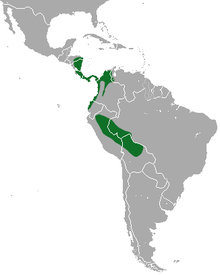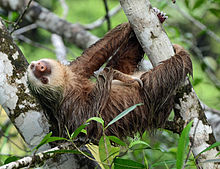
Kingdom: Animalia
Phylum: Chordata
Class: Mammalia
Order: Pilosa
Family: Megalonychidae
Genus: Choloepus
Species: C. hoffmanni
Species: C. hoffmanni
Conservation Status: LC (Least Concerned)
Hoffmann's tow-toed nocturnal and arboreal animal, found in mature and secondary rainforests and deciduous forests. The common name commemorates the German naturalist Karl Hoffmann.
Description
This sloth is a heavily built animal with shaggy fur and slow, deliberate movements. The fore feet have only two toes, each ending with long, curved claws, The three toes sloth also have these same characteristics which may be found in the same
geographic areas, but there are some characteristics that definitely distinguished them from the two toed sloths. Those characteristics include they have the longer snout, separate rather than partially fused toes of the forefeet, the absence of hair on the soles of the feet, and larger overall size. The wrist of the sloth has developed some specific traits due to their slow, yet acrobatic motions. These evolved traits include diminution and distal migration of the pisiform bone. with a loss of contact with the ulna; reduction of the distal end of the ulna to a styloid process, and extremely reduced contact between the ulna and triquetral bone.
This Hoffmann's two-toed sloth is very much related with Linnaeus's two-toed sloth. These two are also very closely resembles. The primary physical differences between the two species relate to suitable skeletal features.
Adults range from 54 to 72 cm in head-body length and weigh from 2.1 to 9 kg. Although they do not have stubby tails, just 1.5 to 3 cm long, this is too short to be visible through the long fur. The claws are 5 to 6.5 cm long. Females are larger on average than males, although with considerable overlap in size. Their fur is tan to light brown in colour, being lighter on the face, but usually has a greenish tinge because of the presence of algae living in the hairs.


Sloths have very poor eyesight and hearing and rely almost entirely on their sense of touch and smell to find food. This sloth is often spits when the mouth opens.


Hoffmann's sloth reach sexual maturity at two to four years of age and have been reported to live up to 32 years in captivity.


Adults range from 54 to 72 cm in head-body length and weigh from 2.1 to 9 kg. Although they do not have stubby tails, just 1.5 to 3 cm long, this is too short to be visible through the long fur. The claws are 5 to 6.5 cm long. Females are larger on average than males, although with considerable overlap in size. Their fur is tan to light brown in colour, being lighter on the face, but usually has a greenish tinge because of the presence of algae living in the hairs.

Habitat
this sloth inhabits tropical forests from sea level to to 3300 m above sea level. It is found in the rainforest canopy in two separate regions of Central and South America, separated by the Andes. One population is found from eastern Honduras in the north to western Ecuador in the south and the other in eastern Peru, Western Brazil and northern Bolivia. According to the study a divergence date of about 7 million years between these populations has been suggested.
Behavior
Two-toed sloth spend most of their time in trees, through they may travel on the ground to move to a new tree. A new study suggests on Barro Colorado Island, these species of sloth is exclusively nocturnal, even though in other locations they are known to be active during day. This is may be because of the competition with brown-throated sloth. They often move slowly through the canopy for about eight hours each night, and spend much of the day sleeping in tangles of lianas, They move only very slowly, typically at around 0.14 m/s, although they can move up to 50% faster when excited. They are solitary in the wild and aside from mothers with young, it is unusual for two be found in a tree at the same time.Sloths have very poor eyesight and hearing and rely almost entirely on their sense of touch and smell to find food. This sloth is often spits when the mouth opens.

Diet
Their main source of diet is tree leaves. Though they also eat fruits and flowers. Sloths have three chambered stomachs. A sloth may take up to a month to completely digest a meal and up to two-thirds of a sloth's weight may be the leaves in its digestive system.Predators
Sloths have many predators, including the jaguars, ocelots, harpy eagles, margays and anacondas.. If threatened, sloth s can defend themselves by slashing out at a predator with their huge claws or biting with their sharp cheek teeth. However, a sloth's main defense is to avoid being in the first place. The two-toed sloth can survive wounds that would be fatal to another mammal its size. The sloth's slow, deliberate movements and algae-covered fur make them difficult for predators to spot from a distance. Their treetop homes are also out of reach for many larger predators.Life Cycle
Courtship consists of the female licking the male's face and rubbing her genitals against the male's body. Gestation lasts between 355 and 377 days, and results in the birth of a single young. The birth takes place in either the ground or in the hanging position. Newborn sloths weight 340 to 454 g. from birth they have long caws and able to cling to their mothers' undersides. The begin to take solid food at 15 to 27 days and are fully weaned by 9 weeks. young sloths make loud bleating alarm calls if separated from their mothers.Hoffmann's sloth reach sexual maturity at two to four years of age and have been reported to live up to 32 years in captivity.

Conservation Status
Habitat destruction is probably causing a decrease in the wild Hoffmann's two-toed sloth population but little reliable data is available on the number of wild individuals. Sloths and people have little contact with one another in the wild.
No comments:
Post a Comment